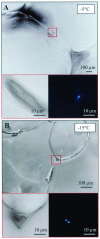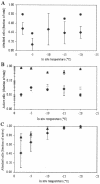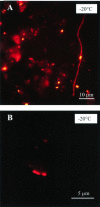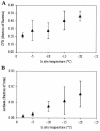Bacterial Activity at -2 to -20 degrees C in Arctic wintertime sea ice
- PMID: 14711687
- PMCID: PMC321258
- DOI: 10.1128/AEM.70.1.550-557.2004
Bacterial Activity at -2 to -20 degrees C in Arctic wintertime sea ice
Abstract
Arctic wintertime sea-ice cores, characterized by a temperature gradient of -2 to -20 degrees C, were investigated to better understand constraints on bacterial abundance, activity, and diversity at subzero temperatures. With the fluorescent stains 4',6'-diamidino-2-phenylindole 2HCl (DAPI) (for DNA) and 5-cyano-2,3-ditoyl tetrazolium chloride (CTC) (for O(2)-based respiration), the abundances of total, particle-associated (>3- micro m), free-living, and actively respiring bacteria were determined for ice-core samples melted at their in situ temperatures (-2 to -20 degrees C) and at the corresponding salinities of their brine inclusions (38 to 209 ppt). Fluorescence in situ hybridization was applied to determine the proportions of Bacteria, Cytophaga-Flavobacteria-Bacteroides (CFB), and Archaea. Microtome-prepared ice sections also were examined microscopically under in situ conditions to evaluate bacterial abundance (by DAPI staining) and particle associations within the brine-inclusion network of the ice. For both melted and intact ice sections, more than 50% of cells were found to be associated with particles or surfaces (sediment grains, detritus, and ice-crystal boundaries). CTC-active bacteria (0.5 to 4% of the total) and cells detectable by rRNA probes (18 to 86% of the total) were found in all ice samples, including the coldest (-20 degrees C), where virtually all active cells were particle associated. The percentage of active bacteria associated with particles increased with decreasing temperature, as did the percentages of CFB (16 to 82% of Bacteria) and Archaea (0.0 to 3.4% of total cells). These results, combined with correlation analyses between bacterial variables and measures of particulate matter in the ice as well as the increase in CFB at lower temperatures, confirm the importance of particle or surface association to bacterial activity at subzero temperatures. Measuring activity down to -20 degrees C adds to the concept that liquid inclusions in frozen environments provide an adequate habitat for active microbial populations on Earth and possibly elsewhere.
Figures





References
-
- Amon, R. M. W., H.-P. Fitznar, and R. Benner. 2001. Linkages among the bioreactivity, chemical composition, and diagenetic state of marine dissolved organic matter. Limnol. Oceanogr. 46:287-297.
-
- Brown, M. V., and J. P. Bowman. 2001. A molecular phylogenetic survey of sea-ice microbial communities (SIMCO). FEMS Microbiol. Ecol. 35:267-275. - PubMed
-
- Cho, C., and F. Azam. 1988. Major role of bacteria in biogeochemical fluxes in the ocean's interior. Nature 332:441-443.
Publication types
MeSH terms
Substances
LinkOut - more resources
Full Text Sources
Miscellaneous

